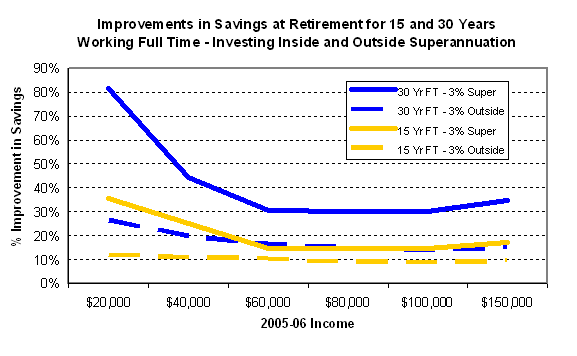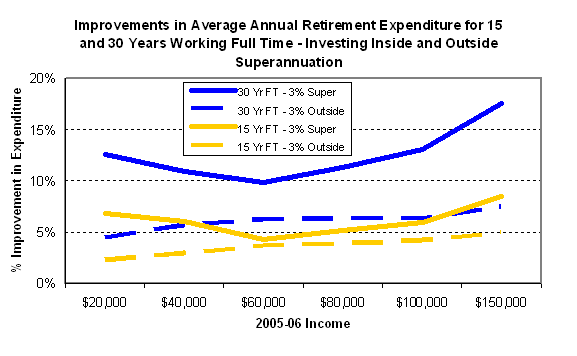The framework for this analysis is similar to that applied to the accumulation phase, but uses the Treasury’s RIMHYPO model to examine effects in the retirement phase. RIMHYPO is used to compare the amounts accumulated at retirement, average annual retirement expenditures and replacement rates (after all taxes) in three situations:
- the first where an amount equivalent to the SG is invested in the superannuation system;
- the second where an amount equivalent to SG plus an additional 3 per cent of pre tax salary is set aside to be invested into the superannuation system (with the additional saving assigned to the optimal strategy for the individual), and;
- the third where the same person invests equivalent additional monies (as available post income tax) outside of the superannuation system (while necessarily retaining the SG investment within superannuation), using the same investment portfolio as used for the superannuation investment.
As was the case when evaluating the accumulation phase, to make a sensible comparison we have to focus on pre tax money as the starting point. Again, all cases are assumed to be within age contribution and RBL limits and are also assumed to meet the eligibility tests for the Government co-contribution (see Appendix C for details).
We also take a simplified framework which assumes all benefits saved within superannuation are taken at age 65 as a complying age pension, and thus receive a 50% asset test exemption and, where income tax in retirement is payable, receive a tax rebate of 15% on pension income. The monies invested outside superannuation are assumed to remain outside the superannuation system in the retirement phase, but are drawn down upon evenly over retirement in a similar manner to the pension.
The benefit gained from investing equivalent monies outside the superannuation system could be improved by investing outside during the accumulation phase, and then placing all proceeds into superannuation as an undeducted contribution just before the point of retirement. The entire accumulation of savings could then be rolled over into a complying pension and be subject to the 50% asset test exemption, which may lead to an increase in age pension benefits over the course of retirement. Thus, the results presented may understate the benefit of investing outside superannuation where a wise investor chooses to utilise the superannuation system at the point of retirement, as described above.
In the analysis as before we consider investing funds additional to the SG in two broad situations specifically impacted by key recent policy changes:
- The abolition of the superannuation surcharge; and
- The expanded co-contribution introduced from July 2004.
Optimal Saving Decision
While the analysis of saving outside superannuation is fairly straightforward (assign 3% of pre tax salary to saving outside superannuation, pay the relevant income tax on those funds and invest the remainder in the assumed portfolio), the saving decision within superannuation can be more complex.
For the cases where the current income is $60,000 or higher, an assumption is made that all saving within the superannuation system is made via salary sacrifice, so that the concessional nature of contributions tax can be utilised. However, for the $20,000 and $40,000 income cases, as indicated in Chart 2, the recently extended Government co-contribution provides a far superior net investment amount into superannuation than can be achieved via salary sacrifice. Thus, if these investors wish to maximise the benefits available from an extra 3% saving within superannuation, they will make post-tax member contributions until such time as they can no longer receive any additional co-contribution, with any residual saving to make up the 3% being assigned to salary sacrifice.
For example, an eligible person with an income of $40,000 can currently contribute $600 to receive a maximum Government co-contribution of $900. This member contribution represents 1.5% of salary, but as income tax must first be paid before this contribution can be made, 2.19% of salary is assigned to saving via this vehicle. Thus, the remaining 0.81% of salary is assumed to be saved via salary sacrifice. As there is no legislated indexation of the maximum amount of co-contribution that can be received, the level of saving necessary to receive the maximum co-contribution benefit is modelled as declining as a percentage of salary over time. To allow for this, it is assumed that the member reassesses the distribution of saving between post-tax member contributions and salary sacrifice every 5 years in order to achieve the optimal savings mix.
Results
Improvements in both savings at the point in retirement and average annual retirement expenditure are presented for a range of incomes in Chart 3 and 4 for both a 30 year working life starting in 2005-06 (retiring at age 65 in 2035-36) and for a person who is part of the way through their working life currently (assumed to have 15 years of working life left, retiring at age 65 in 2020-21, with an existing superannuation balance1).
Chart 3

Chart 4

The results in Chart 3 and 4 highlight that at all income levels (and both ages) analysed, investing within superannuation provides a greater accumulation balance and greater annual retirement expenditure than is achievable outside the superannuation system, where identical investment portfolios and investment returns are used for both cases.
For a person on $40,000, around median earnings, 3% saving within superannuation over a 30 year working life, leads to 44% more private accumulation at retirement than achieved by the SG alone, with part of this coming from the co-contribution. By way of comparison, saving the same amount outside superannuation gives a 20% higher accumulation. Using the superannuation vehicle, the person’s retirement spending, including a part age pension, rises by about 11%. The spending replacement rate in retirement rises significantly from 72% to 82% (see Appendix A for details).
The results show that with the utilisation of the co-contribution, the superannuation system provides incentives to save that are more favourable to lower income earners in the accumulation phase, while providing incentives that are reasonably even across income levels assessed in retirement expenditure terms. This is despite the fact that a significant proportion of retirement expenditure for lower income earners will be provided in the form of age pension outlays, which of course do not grow (and may fall) when a person increases the level of private saving.
The results also highlight that the projected improvements in retirement expenditure are significantly lower than the projected improvements in accumulated savings at the point of retirement. This result is due to the impact of the age pension and retirement taxation on the final retirement expenditure figures. As the age pension makes up a significant proportion of the total retirement expenditure for lower income earners, they have the biggest difference between percentage improvements in the accumulation and retirement phases. This difference is reduced as the proportion of retirement expenditure funded by private saving increases.
1 The assumed current superannuation balance is broadly equivalent to the balance projected for SG contributions from 1992 to 2005.